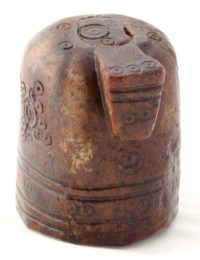 Archaeologists have unearthed a rare medieval chess piece in the remains of a 13th century house in Tønsberg, Norway. It was discovered just before Christmas by a team from the Norwegian Institute of Cultural Heritage Research (NIKU) who were excavating the Anders Madsens gate area of Tønsberg.
Archaeologists have unearthed a rare medieval chess piece in the remains of a 13th century house in Tønsberg, Norway. It was discovered just before Christmas by a team from the Norwegian Institute of Cultural Heritage Research (NIKU) who were excavating the Anders Madsens gate area of Tønsberg.
The cylindrical piece is 30 mm high (1.2 inches) and 26 mm in diameter (1 inch). There’s a wedge jutting out from the top front and it as well as the rest of the body are decorated all over with circles with dots inside. It was carved out of antler and archaeologists believe the maker inserted a piece of lead in the middle of the cylinder to ensure it would hold firm on the chessboard.
Its unusual design suggests it was at least inspired by Arabic art, but that doesn’t mean it was manufactured by Islamic artists or in an Islamic country.
“The design of the piece has an abstract shape, and is designed according to Islamic tradition, where no human figures are to be depicted,” says project manager for the excavation in NIKU Lars Haugesten. […]
“No previous archaeological finds from Tønsberg have such details, which emphasizes that this chess piece is a unique object,” says Haugesten.
Researchers determined that the this piece is a knight. The piece was called an “asb,” meaning horse in Persian in the early form of chess that spread throughout Europe after the Islamic conquest that ended the Sasanian Persian Empire in the 7th century. The game under its Arabic name, shatranj, was brought to Europe via Islamic Spain in the 10th century and from there spread to the far reaches of the continent over the next couple of centuries.
The oldest known chess piece in Scandinavia was found in Lund, Sweden, and dates to the 12th century. It too is of Arabic design and is not dissimilar to the one recently unearthed at Tønsberg. Similar pieces have been found in Bergen, Norway, as well, where more than a thousand game pieces have been discovered in multiple excavations. The Arabic-influenced abstract knight design is very rare. There are only six examples of them among the Bergen pieces, and they have different dimensions and decorative motifs.
 The Anders Madsens dig started in the fall and has so far discovered the remains of streets and houses from the Middle Ages. Artifacts found include a panoply of daily use objects like combs, pottery and antlers. The excavation has been the subject of much interest because Tønsberg is the oldest city in Norway, its founding traditionally dated to 871 A.D. based on the account of 13th century chronicler Snorri Sturluson, and the dig site is located in a key position near Slottsfjell Castle, the royal estate and St. Laurence Church, now no longer standing.
The Anders Madsens dig started in the fall and has so far discovered the remains of streets and houses from the Middle Ages. Artifacts found include a panoply of daily use objects like combs, pottery and antlers. The excavation has been the subject of much interest because Tønsberg is the oldest city in Norway, its founding traditionally dated to 871 A.D. based on the account of 13th century chronicler Snorri Sturluson, and the dig site is located in a key position near Slottsfjell Castle, the royal estate and St. Laurence Church, now no longer standing.